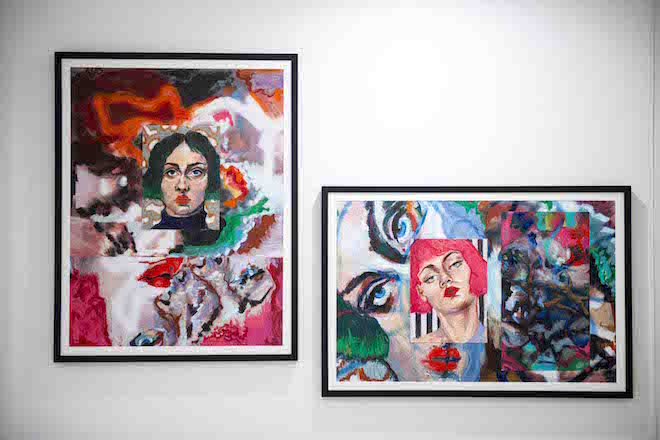Thanks to feminist art historians like Griselda Pollock, Rozsika Parker and Linda Nochlin (Why Have There Been No Great Women Artists?), alongside visionary female art activists such as Guerrilla Girls, and high-profile visionaries like Marina Abramović, Yayoi Kusama and Tracey Emin – all of whom have defied statistics when it comes to the male/female success ratio in the art world – there are increasingly more and more signs of recognition for the value, influence and stature of female artists.
Doing their own bit to ensure that cultural landscape remains is Girls Only. Girl-power gang, women-only wolf-pack, riot grrl clique – however you describe them, the transatlantic collective is an experimental community uniting female artists, encouraging conversation, creativity and expression from a new wave feminist stance. Twin caught up with the group’s founder and curator Antonia Marsh, to find out more.
How did Girls Only evolve?
After I graduated from my Masters in curating, I felt that I needed to generate my own voice as a curator so I decided to work on a project of my own. I left San Francisco for NYC, rented the first studio I viewed and started kitting it out. The first resident started within that month.
So were you an artist yourself too?
I’ve only recently started making art myself but I studied art history and have been working in the art world assisting and curating for ten years now.
What was your vision for the project?
To create a safe space for female artists to talk about and share their work with one another, outside of the exclusivity of a largely patriarchal art world. This vision has developed organically over time – while it remains, what I want more for the artists now is for them to be able to show their work in an exhibition context as much as possible.
So what’s the process – from bringing a community of women together, to promoting the art?
It mostly starts with a conversation or an idea for a smaller project and then snowballs. We do a lot of things – from film screenings to talks and discussion groups, exhibitions, school trips and studio visits – there is a lot of space for artists to get involved.
Were you ever concerned that by calling the group ‘Girls Only’, it immediately alienates men and becomes a feminist conversation?
Of course, this was a major concern from the start of the project. However, with this in mind the choice of name was deliberate. There’s nothing wrong with a feminist conversation, in fact I believe it’s really important that they are engaged with it. Girls Only is not about excluding men, it’s about including artists and providing them with the time, space and money to make work, that might not otherwise have such an opportunity.
At the moment with the under-representation of women in the commercial art world, and in museums and gallery shows, they are the artists that need these opportunities the most.
You’re obviously aware of activists like Guerrilla Girls and the Bunny Collective – do you think we’re having a renaissance for female artists, particularly thanks to the internet?
We actually did a performance project in homage to the Guerrilla Girls in New York! There’s definitely a lot more conversations about it, and I’m doing whatever I can to push in that direction.
Yet there are still many challenges facing female artists. What do you think is the glaringly obvious one?
I think whether or not to identify as female in relation to their work and whether that should be part of their artwork. I think many female artists actually feel inhibited by this and don’t feel the need to relate the work they’re making to their gender. I would imagine that with the burgeoning conversation surrounding feminism in the cultural zeitgeist at the moment, it can be hard to escape constant questions as to where they position themselves, and their practice in relation to this.
And do you think there has been any shift in male attitudes towards women in art?
Not really. I hope they’re freaking out though.
Me too, particularly with so much emerging talent out there. So who are your personal trailblazers – the ones who really shaped freedom of expression for women in art?
Judy Chicago, Cindy Sherman, Carolee Schneeman, Jenny Saville, Tracey Emin, Sarah Lucas.
You recently collaborated with Anti-Agency in London – what was the purpose of pairing up a casting agency with the art world?
Lucy Greene and Pandora Lennard from Anti-Agency approached me after the first Girls Only exhibition in London. A lot of the girls they represent are extremely talented young female artists, and they wanted to give them a chance to show their work. After doing studio visits with them I was really impressed and they were fantastic to work with, I’m really proud of how the show turned out.
And what’s next on your to-do list?
Well the residencies have officially started in London, so at the studio we will have two artists living and working, and at the end they will show their work at different spaces. Our website is also launching, and we are opening temporary studio and exhibition spaces in Paris, Copenhagen and Berlin so we can collaborate with local artists. Hopefully then we will put together a book of everything we’ve done so far.
And finally, how can women continue to ensure the art world keeps recognising their contribution and talent?
Honestly I think the answer to this is really just to keep on making art. It’s as simple and beautiful as that.





 PREVIOUS
PREVIOUS

 Twitter
Twitter
 Tumblr
Tumblr
 YouTube
YouTube
 Facebook
Facebook
 Instagram
Instagram
